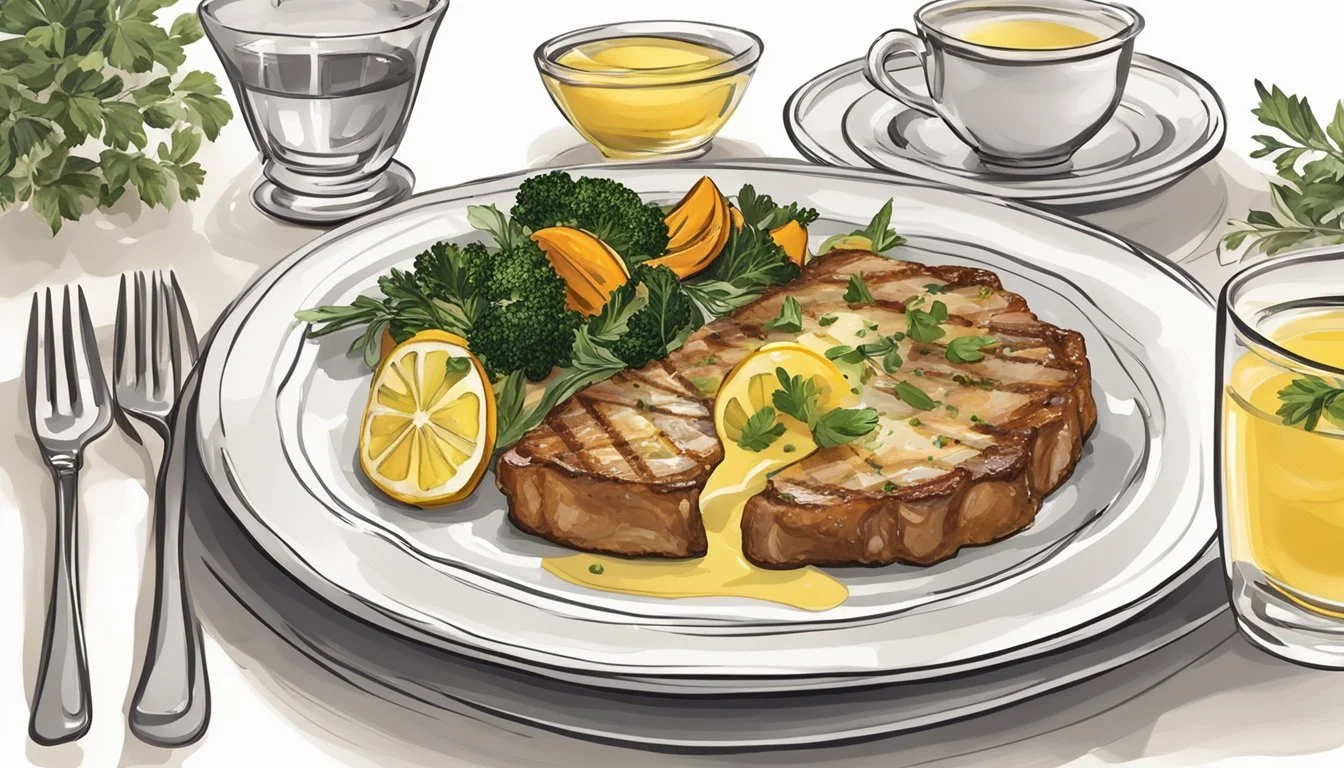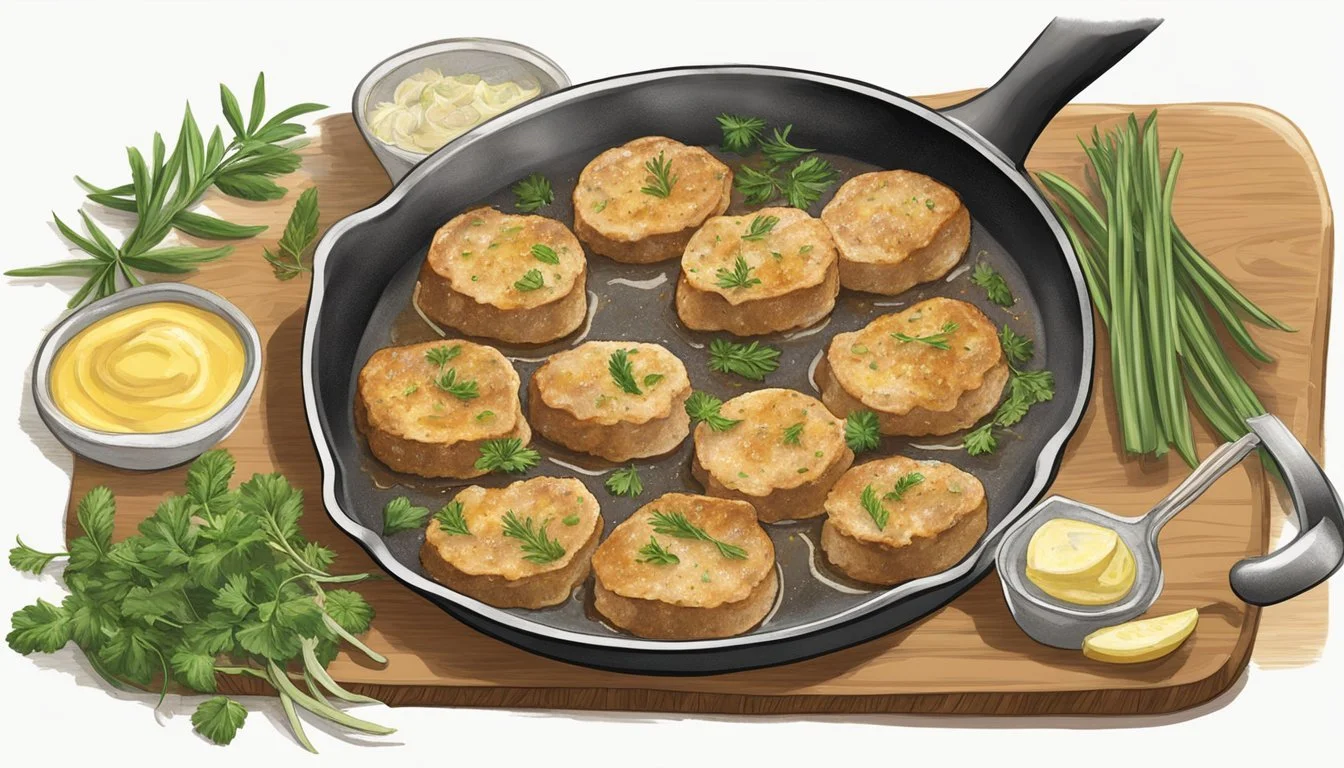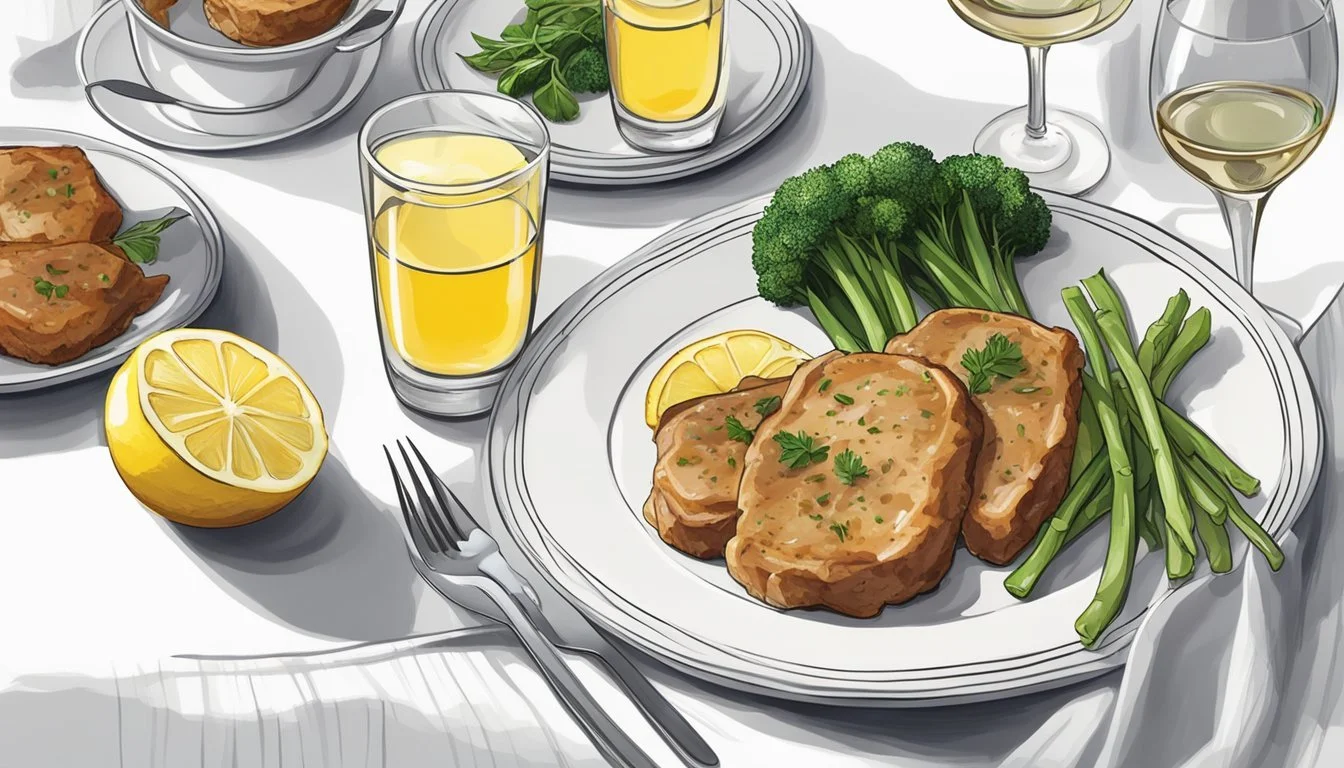How Do You Eat Veal Scallopini?
A Guide to Enjoying This Classic Dish
Veal scallopini is a classic Italian dish that combines thinly sliced veal with a quick, pan-based cooking method to create a tender and flavorful meal. This dish is traditionally made using veal cutlets (What wine goes well with veal cutlets?) that are pounded to an even thinness to ensure rapid and even cooking. The cutlets are then typically dredged in flour and seasoned with salt and pepper before being sautéed in a mixture of butter and oil. The simplicity of veal scallopini’s preparation highlights the delicate texture and mild flavor of the veal, while also allowing the accompanying ingredients and sauces to shine through.
The versatility of veal scallopini lends itself well to a variety of sauces and garnishes, often featuring elements such as lemon juice, white wine, capers, (What wine goes well with capers?) and fresh herbs. These ingredients not only add a depth of flavor but also create a light sauce that complements the veal's subtle taste. Mushrooms are another common addition, bringing a savory earthiness to the dish. The key to perfect veal scallopini lies in the balance of flavors and the careful not to overcook the veal, maintaining its tenderness.
Enjoying veal scallopini is an experience best served with appropriate side dishes that can absorb the rich sauce, such as a bed of pasta, risotto, or a side of roasted vegetables. The presentation of the dish is typically straightforward, with the golden-brown cutlets dressed in sauce and garnished with a slice of lemon or a sprinkle of chopped parsley for additional freshness. The result is an elegantly simple yet satisfying meal that speaks to the heart of Italian culinary tradition.
Ingredients and Preparations
Creating an exceptional veal scallopini requires specific ingredients and careful preparation. This section delves into the key components and preparatory steps that one should follow for a successful dish.
Selecting Ingredients
The main ingredient is veal cutlets, which should be fresh and of high quality. Common ingredients used to enhance the veal's flavor include all-purpose flour, salt, pepper, butter, olive oil, lemon juice, garlic, parsley, and capers. Optional items such as parmesan, oregano, or rosemary can add a unique twist to the recipe.
Prep Work Prior to Cooking
Prior to cooking, veal cutlets must be patted dry with a paper towel and pounded to a uniform thickness using a meat mallet on a cutting board. This ensures even cooking. Each cutlet can be lightly coated in a seasoned flour mixture for added flavor and texture.
Cookware Choices
A large frying pan is essential. It should distribute heat evenly to avoid uneven cooking. For sautéing or making the sauce, pans with a heavy bottom are preferred to prevent burning.
Veal Scallopini Variations
Veal piccata includes a sauce of lemon, butter, and capers, while veal milanese involves breading and frying the cutlets. Alternatives like pork or chicken can also be used for different dietary preferences or availability.
Measurement and Substitution
Use measuring cups and spoons for accurate ingredient quantities. For those with dietary restrictions, gluten-free flour can replace all-purpose flour, and a variety of oils can substitute for olive oil if needed.
Pre-Meal Preparation
Preparing a suitable side dish complements the main course. Options include potatoes, pasta, rice, or bread to absorb the flavorful sauce or to add a contrasting texture.
Advanced Preparations
To expedite the cooking process, some steps can be done in advance such as making the sauce or pounding the veal cutlets. Store the prepped items properly to maintain freshness.
Nutrition Prep Guidance
Consider the nutritional content of your dish — cut back on butter or cream to reduce calories, or alter the recipe to align with nutrition facts and dietary goals. Each ingredient contributes to the final nutritional profile of the dish.
Cooking Process
Crafting an exquisite veal scallopini involves a series of steps that transform simple ingredients into a harmonious and flavorful dish. Precision in cooking the veal, creating the sauce, and serving contribute to the dish's success.
Cooking Steps Overview
The veal scallopini cooking process is a systematic approach consisting of seasoning and cooking thin veal cutlets, preparing a complementary sauce, combining them, and serving with appropriate garnishing and sides.
Cooking the Veal
Start by seasoning the veal fillets with salt and pepper. Then, coat each fillet lightly in flour, ensuring it's evenly covered but not heavily dredged. In a medium frying pan, heat a mix of butter and oil over a medium flame. Cook the veal for approximately 5 minutes each side, until it reaches an internal temperature that assures it is both tender and safe to eat.
Preparation of the Sauce
Once the veal is cooked and set aside, use the same pan to prepare the sauce. This typically involves deglazing the pan with liquids such as white wine and chicken broth to incorporate the flavorful browned bits from the veal. The acidic component, like lemon juice, is added along with capers for a tangy touch. The sauce is cooked until it has reduced and slightly thickened to a creamy consistency.
Combining and Serving
After the sauce has reached its desired consistency, the veal is returned to the skillet to be coated in the sauce and rewarmed gently. This step is critical to ensure the veal remains moist and soaks up the flavors of the sauce.
Garnishing Techniques
Garnishes such as freshly chopped parsley and slices of lemon are not only visually appealing but also contribute to the freshness and authentic lemony profile of the dish.
Final Touches
To ensure the presentation looks as good as the flavors, use tongs to place the veal onto plates, and spoon over even amounts of sauce. Wipe any drips from the edges of the plates for a clean presentation.
Ensuring Perfect Texture
Monitoring the internal temperature of the veal is essential for it to remain tender. Overcooking can lead to a tough texture, while undercooking presents a safety concern.
Serving Suggestions
Veal scallopini pairs well with a variety of sides, including pasta, crusty bread, mashed potatoes, or steamed green beans, which complement the dish without overshadowing its delicate flavor profile.
Safe Cooking Practices
Always practice safe cooking habits, such as using a meat thermometer to check for a safe internal temperature and ensuring all utensils and surfaces are clean. Veal should be cooked to a minimum internal temperature of 145°F (63°C) according to USDA guidelines. Capers should be rinsed and drained if they are preserved in brine to avoid an overly salty sauce.
Presentation and Serving
Elevate the dining experience of veal scallopini by mastering the art of presentation and serving. This section guides you through the intricacies of plating, selecting sides, and wine pairings, while addressing garnishing, crafting a complete meal, maintaining portion sizes, and following dining etiquette.
Plating the Veal Scallopini
The veal scallopini should be plated hot, with the tender veal cutlets arranged in a single layer to prevent sogginess. Drizzle the sauce, typically a reduction of white wine with lemon and capers, directly over the veal to enhance the flavors and preserve the dish's appealing appearance.
Accompaniments and Side Dishes
Veal scallopini pairs beautifully with:
Potatoes: Roasted or mashed for a comforting addition.
Pasta: A light linguine or angel hair complements the veal's subtle flavors.
Vegetables: Steamed broccoli or sautéed mushrooms add color and nutritional balance.
Wine Pairing Suggestions
Pair the veal with a dry white wine that complements the acidity of the lemon-caper sauce. A crisp Pinot Grigio or an unoaked Chardonnay will balance the dish's richness and enhance the overall taste profile.
Garnishing for Visual Appeal
Garnish the plate with fresh parsley for a pop of color and to add a subtle freshness to the dish. A lemon wedge can be provided for guests who prefer a sharper citrus note.
Serving a Complete Meal
When serving a complete meal, consider a simple appetizer like a light salad or bruschetta, followed by the veal scallopini as the main course. This ensures a progression of flavors and an authentic Italian dining experience.
Portion Control
For a weeknight meal or dinner party, one veal cutlet per person is usually sufficient, especially when accompanied by sides. This consideration helps manage calories and overall nutrition.
Dining Etiquette
Serving veal scallopini requires proper etiquette. Provide each guest with a set of clean utensils and ensure the dishes are passed correctly, to the left, from diner to diner. Encourage guests to savor the meal in a medium-paced manner, reflecting its authentic and Italian heritage.
Post-Meal Tips
After enjoying veal scallopini, it’s important to handle the leftovers carefully to ensure food safety and maintain quality. Below are specific tips on storing, reheating, and repurposing any uneaten veal scallopini, as well as responsibly dealing with used cooking oils.
Proper Storage
Veal Scallopini should be placed in an airtight container and refrigerated within two hours of cooking. It is best consumed within 3-4 days. If the dish includes a cream or butter sauce, ensure it's cooled down before sealing to avoid excess condensation, which can affect the texture.
Reheating Instructions
To reheat leftovers, use the oven or microwave for best results. For the oven, preheat it to 350°F (175°C) and heat the veal covered in foil for 10-15 minutes. In the microwave, use a microwave-safe dish, cover with a microwave-safe lid, and reheat on medium power to avoid drying out the scallopini. Check periodically to prevent overheating.
Repurposing Leftovers
Get creative with leftovers to make new dishes. Veal scallopini can be sliced and added to salads, sandwiches, or pasta. For a touch of variety, incorporate recipe variations using different sauces or vegetables, transforming the dish into something new and exciting for the next meal.
Recycling Cooking Oil
After cooking veal scallopini, do not dispose of vegetable oil or olive oil in the sink. Instead, once it’s cool, pour it into a container and dispose of it with solid waste. Some communities offer recycling programs for used cooking oil, which can be turned into biodiesel, so consider reaching out to your local waste management services for more details.
Frequently Asked Questions
This section addresses common inquiries related to preparing veal scallopini, ranging from cooking techniques to accommodating dietary restrictions, ensuring home cooks can achieve the best results with confidence.
Cooking and Safety Queries
Is there a specific internal temperature veal scallopini should reach?
For safe consumption, veal should reach an internal temperature of 145 degrees Fahrenheit. Utilize a meat thermometer to verify proper cooking.
What are safe cooking practices for veal scallopini?
Thoroughly cook the veal to the recommended internal temperature.
Avoid cross-contamination by using separate cutting boards for raw meats and other ingredients.
Store leftovers in an airtight container and refrigerate promptly.
Ingredient Substitutions
Can unsalted butter be replaced in veal scallopini recipes?
Yes, if unsalted butter is not available, salted butter can be used. Adjust added salt in the recipe to maintain the flavor balance.
How can olive oil be substituted in veal scallopini?
For a different fat option, consider using avocado oil or another high smoke point oil to avoid burning.
Recipe Adjustment for Dietary Needs
Is it possible to make veal scallopini gluten-free?
Sure, replace all-purpose flour with a gluten-free alternative for dredging the veal cutlets.
How can nutrition be optimized in veal scallopini recipes?
Use less butter or oil to lower the fat content.
Serve with a side of steamed vegetables to enhance the nutritional value.
Troubleshooting Common Issues
What should one do if the veal scallopini is undercooked?
Return the veal to the pan and cook each side for an additional 1-2 minutes or until the desired internal temperature is reached.
How can one fix burned veal scallopini?
If the veal is only slightly charred, one can scrape off the burned bits; if it's severely burned, it's safer to discard and start anew.
Expert Tips for Best Results
What techniques ensure the best flavor balance in veal scallopini?
Do not overcrowd the pan when cooking veal cutlets, as this can cause them to steam rather than sear.
Pair veal with acidic components like lemon juice in veal piccata or tomato sauce in veal milanese to cut through the richness of the meat.
How does one achieve a perfectly cooked veal scallopini?
Cook veal over medium heat to ensure even browning and to avoid undercooking the center or overcooking the exterior. A properly preheated pan is crucial.
Related Variants and Dishes
Veal scallopini, a classic Italian dish, has inspired a variety of related dishes. These variations include different meats and international flavors, each offering a unique twist on the traditional recipe.
Other Scallopini Dishes
Scallopini refers to a method of preparing meat: thin slices of protein are pounded thin, coated in flour, and quickly sautéed. Although veal is traditional, other meats such as chicken and pork can be used. Two popular variations include:
Chicken piccata (What wine goes well with chicken piccata?): This dish substitutes chicken for veal, maintaining the delicate texture and rich, lemon-caper sauce typical of scallopini.
Pork scallopini: A heartier option, pork provides a robust flavor while keeping the meat tender and the preparation similar to veal scallopini.
International Takes on Veal Scallopini
Different cultures have adapted the classic veal scallopini to their tastes, resulting in unique international variations. For instance:
Veal piccata: While itself an Italian dish, veal piccata has seen variations in other cuisines, often adjusting the level of lemon or capers in the sauce.
Veal Milanese: A dish similar to veal scallopini but with an emphasis on a crisp breadcrumb coating rather than a flour-based one, frequently served with a wedge of lemon or a light salad.
Veal Alternatives
While veal is the traditional meat used in scallopini, there are various alternatives that cater to different preferences or dietary needs:
Beef: Thin beef cutlets can be used as a substitute, offering a more pronounced flavor while still absorbing the surrounding flavors well.
Chicken: A common alternative, chicken offers a leaner option while still providing the satisfying experience of a breaded and sautéed cutlet.
Pork: For those who prefer pork, using thinly-sliced pork loin offers a scallopini experience with a slightly richer taste profile.
Each of these alternatives to veal scallopini provides a different avenue to explore the concept of scallopini, inviting experimentation and personalization.
Conclusion
Veal scallopini serves as an exemplary choice for a weeknight dinner due to its quick and easy preparation methods. It does not require extensive cooking time, which stands in favor of those seeking a sophisticated meal without investing hours in the kitchen. With its thin cuts, veal cooks rapidly on the stovetop, often needing only a handful of minutes per side.
The versatile nature of veal scallopini allows for a variety of sauces to accompany the tender meat. The addition of a lemon-butter sauce, capers, or a wine reduction enhances the dish's flavors, while still maintaining a simplicity that is approachable for any home cook.
Here are some key takeaways:
Efficiency: Veal scallopini is quick-to-cook, ideal for a time-sensitive dinner plan.
Flavorful: A swift deglaze of the pan with lemon or wine creates a rich, flavorful base for a sauce that complements the veal.
Adaptable: The meal pairs wonderfully with a range of side dishes, from traditional pasta to steamed vegetables, catering to diverse palates and dietary preferences.
For individuals valuing both taste and time, veal scallopini stands as a brilliant solution—effortless yet elegant. It satisfies the desire for a meal that feels special, even when the clock is ticking. This dish truly exemplifies how home cooking can be both practical and delightful.






